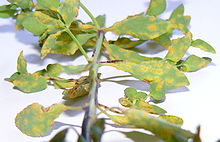| Uromyces | |
|---|---|

| |
| Uromyces pisi-sativi on leaves of cypress spurge ( Euphorbia cyparissias) | |
|
Scientific classification
| |
| Domain: | Eukaryota |
| Kingdom: | Fungi |
| Division: | Basidiomycota |
| Class: | Pucciniomycetes |
| Order: | Pucciniales |
| Family: | Pucciniaceae |
| Genus: |
Uromyces ( Link) Unger (1833) [1] |
| Type species | |
| Uredo appendiculata
Pers. (1796)
| |
| Synonyms [2] | |
| |
Uromyces is a genus of rust fungi in the family Pucciniaceae. The genus was described by Franz Unger in his 1833 work Die Exantheme der Pflanzen. They have a worldwide distribution but large occurrences happen in North America and Europe. [2]
The genus is the second-largest plant pathogenic rust genus, which is responsible for various plant affecting diseases, and it has major effects on both agricultural and non-agricultural plants. The genus is generally characterized by its unicellular teliospores (thick-walled resting spores) that help to characterize it and distinguish it from another important and large rust genus, Puccinia. [3]
The Uromyces fungal species have been recorded on various host plants belonging to a wide range of the families, including Asteraceae, Euphorbiaceae, Fabaceae, Liliaceae, Loranthaceae, and Poaceae. Family Loranthaceae is listed to be the most affected by the fungus. [3]
Species
As of 2023 August 22 [update], the GBIF lists up to 1,048 species, [2] while Species Fungorum lists about 1,239 species (with many former species). [4] The Encyclopedia of Life lists 969 species. [5]
Selected species in the genus Uromyces include:
- Uromyces apiosporus
- Uromyces appendiculatus
- Uromyces betae - beet rust
- Uromyces beticola - bean rust
- Uromyces ciceris-arietini - chickpea rust
- Uromyces dianthi carnation rust
- Uromyces elegans
- Uromyces euphorbiae
- Uromyces graminis
- Uromyces inconspicuus
- Uromyces medicaginis
- Uromyces musae
- Uromyces oblongus
- Uromyces pisi-sativi - pea rust
- Uromyces straitus - alfalfa or lucerne rust
- Uromyces trifolii-repentis - clover rust
- Uromyces vignae - cowpea rust
References
- ^ Unger F. (1833). Die Exantheme der Pflanzen und einige mit diesen verwandte Krankheiten der Gewächse : pathogenetisch und nosographisch dargestellt (in German). p. 277.
- ^ a b c "Uromyces (Link) Unger, 1833". www.gbif.org. Retrieved 22 August 2022.
- ^ a b Gautam, Ajay Kumar; Avasthi, Shubhi; Verma, Rajnish Kumar; Sushma; Niranjan, Mekala; Devadatha, Bandarupalli; Jayawardena, Ruvishika S.; Suwannarach, Nakarin; Karunarathna, Samantha C. (14 June 2022). "A Global Overview of Diversity and Phylogeny of the Rust Genus Uromyces". J. Fungi (Basel). 8 (6): 633. doi: 10.3390/jof8060633. PMC 9224716. PMID 35736116.
- ^ "Species Fungorum - Search Page - Uromyces". www.speciesfungorum.org. Retrieved 22 August 2023.
- ^ "Uromyces - Encyclopedia of Life". eol.org. Retrieved 22 August 2023.
External links
- Species Profile - Gladiolus Rust (Uromyces transversalis), National Invasive Species Information Center, United States National Agricultural Library. Lists general information and resources for Gladiolus Rust.
| Uromyces | |
|---|---|

| |
| Uromyces pisi-sativi on leaves of cypress spurge ( Euphorbia cyparissias) | |
|
Scientific classification
| |
| Domain: | Eukaryota |
| Kingdom: | Fungi |
| Division: | Basidiomycota |
| Class: | Pucciniomycetes |
| Order: | Pucciniales |
| Family: | Pucciniaceae |
| Genus: |
Uromyces ( Link) Unger (1833) [1] |
| Type species | |
| Uredo appendiculata
Pers. (1796)
| |
| Synonyms [2] | |
| |
Uromyces is a genus of rust fungi in the family Pucciniaceae. The genus was described by Franz Unger in his 1833 work Die Exantheme der Pflanzen. They have a worldwide distribution but large occurrences happen in North America and Europe. [2]
The genus is the second-largest plant pathogenic rust genus, which is responsible for various plant affecting diseases, and it has major effects on both agricultural and non-agricultural plants. The genus is generally characterized by its unicellular teliospores (thick-walled resting spores) that help to characterize it and distinguish it from another important and large rust genus, Puccinia. [3]
The Uromyces fungal species have been recorded on various host plants belonging to a wide range of the families, including Asteraceae, Euphorbiaceae, Fabaceae, Liliaceae, Loranthaceae, and Poaceae. Family Loranthaceae is listed to be the most affected by the fungus. [3]
Species
As of 2023 August 22 [update], the GBIF lists up to 1,048 species, [2] while Species Fungorum lists about 1,239 species (with many former species). [4] The Encyclopedia of Life lists 969 species. [5]
Selected species in the genus Uromyces include:
- Uromyces apiosporus
- Uromyces appendiculatus
- Uromyces betae - beet rust
- Uromyces beticola - bean rust
- Uromyces ciceris-arietini - chickpea rust
- Uromyces dianthi carnation rust
- Uromyces elegans
- Uromyces euphorbiae
- Uromyces graminis
- Uromyces inconspicuus
- Uromyces medicaginis
- Uromyces musae
- Uromyces oblongus
- Uromyces pisi-sativi - pea rust
- Uromyces straitus - alfalfa or lucerne rust
- Uromyces trifolii-repentis - clover rust
- Uromyces vignae - cowpea rust
References
- ^ Unger F. (1833). Die Exantheme der Pflanzen und einige mit diesen verwandte Krankheiten der Gewächse : pathogenetisch und nosographisch dargestellt (in German). p. 277.
- ^ a b c "Uromyces (Link) Unger, 1833". www.gbif.org. Retrieved 22 August 2022.
- ^ a b Gautam, Ajay Kumar; Avasthi, Shubhi; Verma, Rajnish Kumar; Sushma; Niranjan, Mekala; Devadatha, Bandarupalli; Jayawardena, Ruvishika S.; Suwannarach, Nakarin; Karunarathna, Samantha C. (14 June 2022). "A Global Overview of Diversity and Phylogeny of the Rust Genus Uromyces". J. Fungi (Basel). 8 (6): 633. doi: 10.3390/jof8060633. PMC 9224716. PMID 35736116.
- ^ "Species Fungorum - Search Page - Uromyces". www.speciesfungorum.org. Retrieved 22 August 2023.
- ^ "Uromyces - Encyclopedia of Life". eol.org. Retrieved 22 August 2023.
External links
- Species Profile - Gladiolus Rust (Uromyces transversalis), National Invasive Species Information Center, United States National Agricultural Library. Lists general information and resources for Gladiolus Rust.